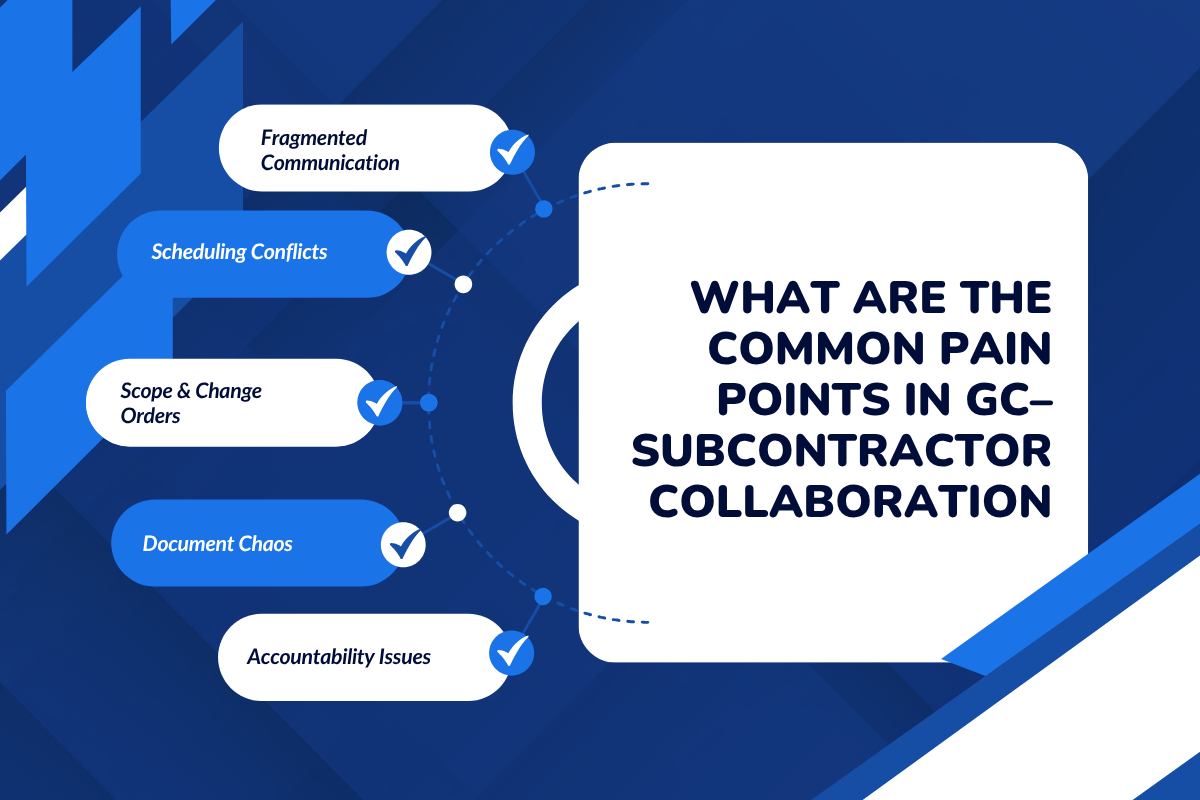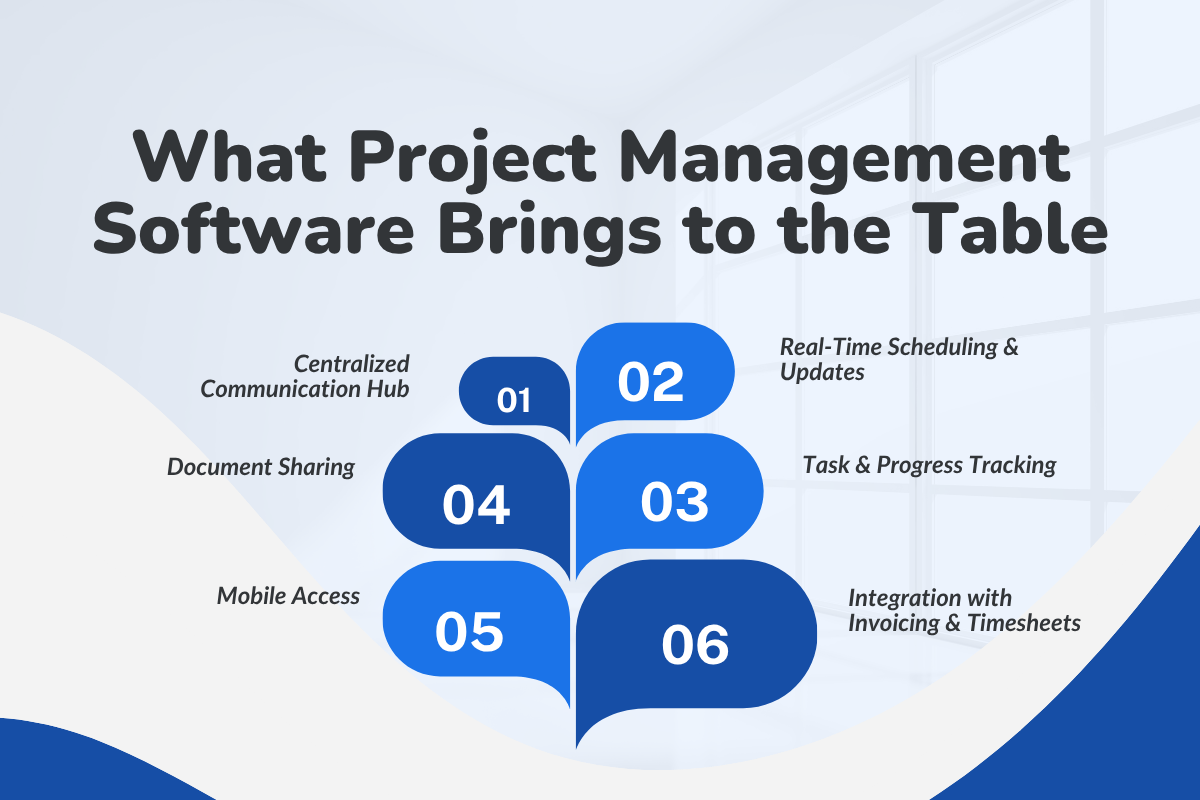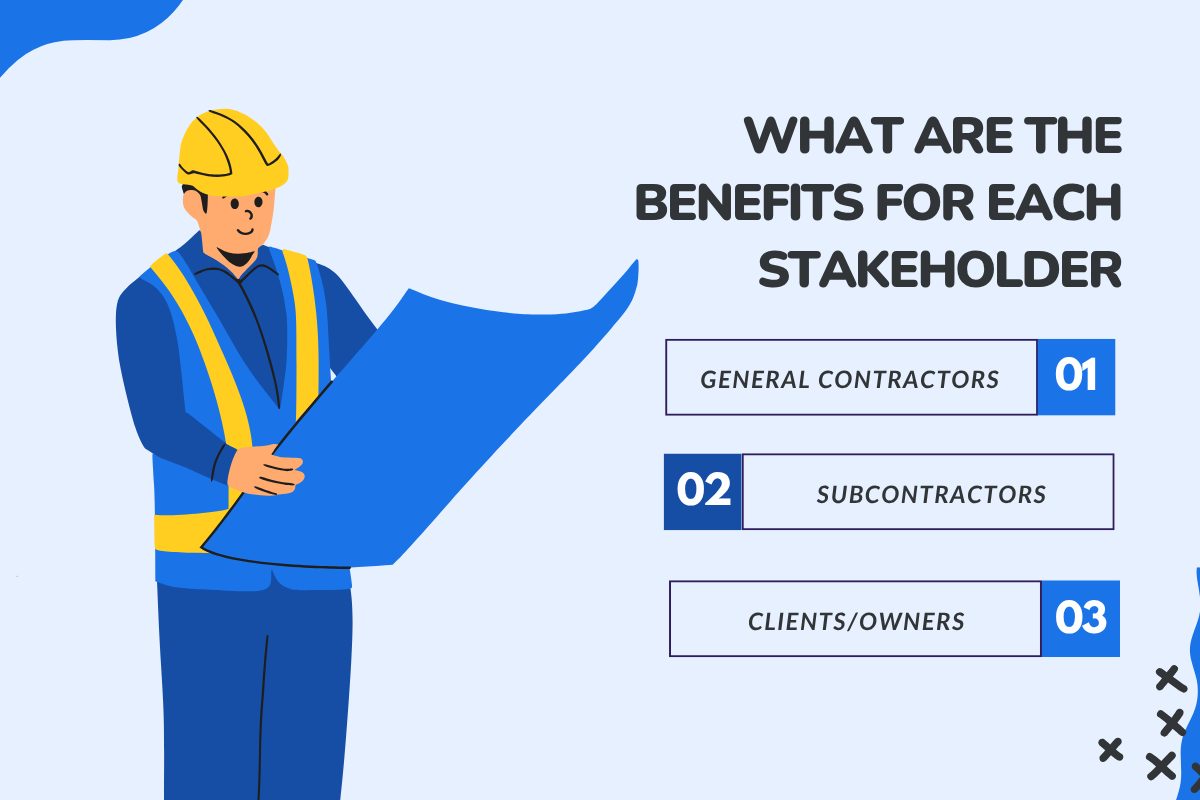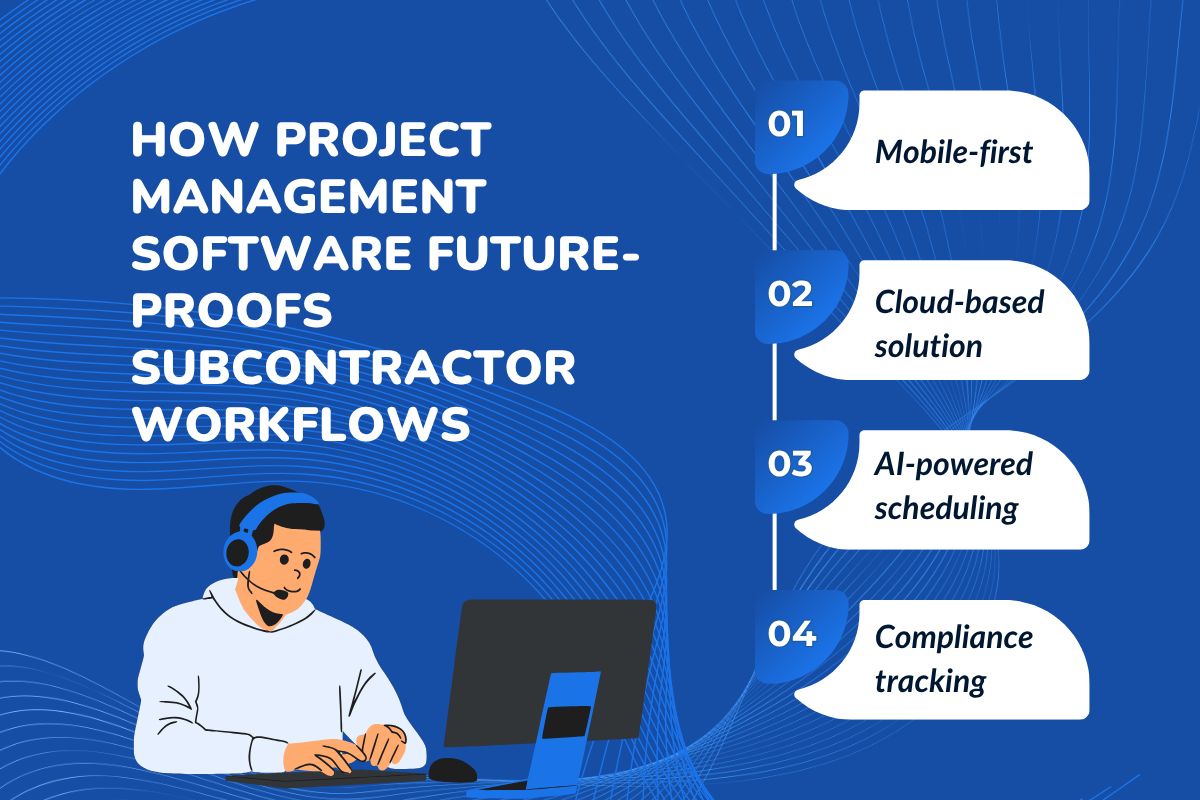Subcontractor collaboration is one of the biggest challenges in construction. This means misaligned schedules, scattered documents, and unclear communication can quickly derail a project.
But the right project management software brings everyone onto a single platform, keeping teams connected, tasks organized, and projects running smoothly from start to finish.
Effective project management software keeps everyone on the same page, making communication, scheduling, and document sharing simple. This helps subcontractors work efficiently and ensures projects stay on track.
How Top Builders Use Construction Project Management Software to Collaborate Efficiently
If you’ve ever managed a construction project, you know subcontractor collaboration can feel like juggling fire. Subcontractors are essential partners in business processes, but miscommunication, scheduling conflicts, and scattered documents often turn simple projects into headaches.
That’s where construction management software comes in. It connects general contractors, subcontractors, and project teams on a single platform, ensuring clear communication, aligned schedules, and smooth project execution.
In this article, we’ll explore why collaboration is so challenging, the common pain points, and how construction project management software helps deliver projects with less stress.
Key Takeaways
- Subcontractor collaboration challenges—like miscommunication, scheduling conflicts, and scattered documents—often derail projects and inflate costs.
- Project management software unites general contractors, subcontractors, and clients on a single platform, ensuring everyone works from the same data source.
- Centralized communication prevents missed updates, while real-time scheduling and digital documentation eliminate confusion and rework.
- Accountability improves through task tracking, progress visibility, and instant change order updates.
- Cloud and mobile access empower on-site teams to stay informed, upload progress, and respond to issues instantly.
- Integrated invoicing and timesheets ensure transparency, faster approvals, and timely payments for subcontractors.
Why Subcontractor Collaboration Is So Hard
Subcontractors are the backbone of any construction project. Without them, tasks like electrical, plumbing, roofing, or HVAC work wouldn’t get done. But anyone who has managed subcontractors knows the friction points all too well.
For instance: You’re on site, waiting for the drywall crew, but they don’t arrive because they were double-booked. The electricians show up anyway, only to find they can’t start until the drywall is up. Meanwhile, your client calls to ask why the schedule is slipping. It’s stressful, and unfortunately, it happens far too often.
Now the question arises: Why does this usually happen? Subcontractor collaboration often relies on outdated methods, spreadsheets, endless phone calls, and scattered email chains.
Therefore, effective document management is essential. When schedules shift or scope changes, not everyone gets the update. The outcome for that is missed deadlines, blown budgets, and frustrated clients. Project management software solves these challenges by aligning GCs and subs in real time. Instead of relying on memory or scattered notes, everyone works from a single, unified source of truth.
What Are The Common Pain Points in GC–Subcontractor Collaboration

Before exploring solutions, let’s highlight the most common hurdles in subcontractor management, particularly when it comes to data. If you’ve been in construction long enough, these will sound familiar:
1. Fragmented Communication
Construction is all about coordination, yet communication often spans multiple channels: phone calls, emails, and texts.
One missed message can lead to days of delays, and without a centralized hub, important updates also fall through the cracks.
It also forces project teams to waste time chasing information instead of moving work forward. Over time, this constant back-and-forth hinders productivity and erodes trust between general contractors and subcontractors, underscoring the need for more effective communication and collaboration processes.
2. Scheduling Conflicts
When multiple trades need access to the same site, overlap is inevitable. Without proper subcontractor scheduling tools, coordination quickly turns into chaos: electricians waiting on drywallers, roofers arriving during inspections, and teams blaming each other for delays.
These minor clashes add up, slowing down the entire project and frustrating crews who feel their time is being wasted. Whereas a clear, shared schedule helps keep everyone in sync and prevents those costly on-site standstills.
3. Scope & Change Orders
Change orders are a standard part of every project, but when they’re not documented clearly, they can lead to disputes. Subs may claim they weren’t informed, while GCs argue the opposite.
It’s a recipe for conflict and added costs. Without a proper system, even small changes can spiral into big misunderstandings. In this case, clear documentation and instant updates make sure everyone’s on the same page before work moves forward.
4. Document Chaos
Drawings, permits, contracts, and inspection reports often live in different folders, inboxes, or physical binders. Subs might work off outdated drawings simply because they didn’t have the latest version.
This not only slows down progress but also increases the chance of costly mistakes. Having a central hub for documents ensures that everyone works with the most accurate information.
5. Accountability Issues
When problems arise, it can be hard to verify who was responsible. Without clear task assignments and digital records, accountability is blurry, and costly mistakes are harder to track and fix.
Misunderstandings often turn into finger-pointing, which only wastes more time. With proper systems in place, you get transparency that keeps everyone honest and projects on track.
Boost your team’s efficiency and project success by mastering construction CRM training. Training Your Team to Maximize Construction CRM Benefits
What Project Management Software Brings to the Table

So, how does project management software help construction teams overcome these issues? By centralizing everything, communication, schedules, documents, and tasks into one platform.
> Centralized Communication Hub
No more chasing down texts or digging through emails. With construction management software, every conversation is logged in one place, making it easier to track and respond quickly.
Team members can see updates in real time, ask questions, and share notes without playing phone tag. This way, everyone stays on the same page, misunderstandings are minimized, and the entire project team can move forward with confidence.
> Real-Time Scheduling & Updates
When a schedule changes, subcontractors and project teams receive the update instantly, resulting in fewer site conflicts and more efficient workflows. Everyone is working off the same timeline, so there’s no confusion about who should be on-site and when.
Teams can adjust their tasks on the fly, coordinate better, and avoid costly delays, making the entire construction project run smoothly and more predictably.
> Document Sharing
All drawings, contracts, and change orders are stored in one secure location, ensuring that everyone on the project has access to the most up-to-date information.
Subcontractors always work from the latest set, which reduces costly rework and avoids confusion on-site.
Team members can quickly review, download, or comment on documents, making collaboration seamless and keeping the entire construction project organized and on track.
> Task & Progress Tracking
Project managers can assign tasks, track progress, and review updates in real-time, providing everyone with a clear view of what needs to be done and by what time.
Moreover, accountability improves because each team member knows exactly what they’re responsible for and can see how their work fits into the bigger picture.
This visibility helps catch potential delays early, keeps the workflow smooth, and ensures the entire project stays on schedule without unnecessary surprises.
> Mobile Access
Most subs spend their day on-site, not behind a desk, so having access to project information on the go is a game-changer. Cloud-based solutions enable them to check schedules, upload photos, or review necessary documents directly from their phones, without needing to return to the office.
This instant access keeps everyone on the same page, reduces delays, and makes it easier to address issues as they arise, ensuring the job progresses smoothly from start to finish.
> Integration with Invoicing & Timesheets
Subs often worry about getting paid on time, which can distract them from their work and negatively impact their cash flow and money management. By integrating timesheets and invoices directly into construction management software, tracking hours and completed tasks becomes transparent for all parties involved.
This reduces disputes, speeds up approvals, and ensures payments occur more quickly, while providing project managers with a clear view of labor costs and productivity across the entire project.
Recent industry studies indicate that over 65% of construction projects are delayed, exceed budget, or are impacted by non-compliance.
Key Features That Boost Subcontractor Collaboration

Modern construction project management software isn’t just about keeping things organized; it's also about streamlining processes and enhancing efficiency.
It’s designed with tools that facilitate smoother collaboration between GCs and subcontractors.
1. Shared Dashboards: Everyone sees project milestones and updates in one place. This transparency eliminates confusion about timelines, ensures all stakeholders are on the same page, and makes it easy to spot delays before they become big problems.
2. Digital Scheduling Tools: With complete visibility into the project schedule, subcontractors can see when other trades are on-site. This prevents overlaps, avoids downtime, and keeps the workflow running efficiently without constant back-and-forth calls
.
3. Change Order Management: Instant documentation of change orders ensures everyone is aware of adjustments as they happen. Subs know precisely what’s expected, disputes are minimized, and the project moves forward without costly misunderstandings.
4. Real-Time Messaging & Alerts: Quick notifications replace endless phone chains and emails. Teams can instantly communicate updates, respond to questions, and resolve minor issues before they escalate, keeping everyone connected, even across multiple sites.
5. File Version Control: Subs always access the latest drawings, not outdated PDFs buried in someone’s inbox.
6. Field Reporting Tools: Crews can upload photos, notes, and punch lists straight from the job site.
Together, these features keep subcontractors informed, engaged, and accountable, helping the entire project stay on track.
Find out how the right construction project management software can simplify your projects and enhance team performance and productivity by reading: The Ultimate Guide to Construction Project Management Software.
What Are The Benefits for Each Stakeholder

The beauty of construction project management software is that it benefits not only general contractors but everyone involved in the project.
> General Contractors
For GCs, collaboration headaches drop dramatically. With better accountability and clear communication, projects are easier to manage, and clients trust the process more.
> Subcontractors
Subs enjoy greater clarity on scope and faster payments, thanks to streamlined invoicing and fewer last-minute surprises. They can focus on doing the work instead of chasing down information.
> Clients/Owners
When subcontractor collaboration improves, clients see projects delivered on time, within budget, and with fewer disputes. That strengthens your reputation and increases repeat business.
How Project Management Software Future-Proofs Subcontractor Workflows

The construction industry isn’t slowing down, and neither are its challenges. Project management software helps future-proof your business processes by making collaboration more resilient.
- Mobile-first: Subs update tasks, upload photos, and review schedules directly from the field.
- Cloud-based solution: Instantly accessible for dispersed teams across different job sites.
- AI-powered scheduling: Predict and prevent trade clashes before they happen.
- Compliance tracking: Keep safety checklists, permits, and insurance documents up to date and easily verifiable.
By adopting these tools, construction companies can respond more quickly, ensuring the efficient integration of subcontractors, and deliver projects with fewer delays and disputes.
37.4% of construction firms cite communication and stakeholder coordination as a major operational challenge.
Conclusion: Greater Collaboration Leads to Stronger Results in Projects
Subcontractor collaboration can make or break a construction project, and miscommunication leads to delays, higher costs, and damaged reputations.
Using the right construction project management software can make all the difference. It centralizes communication, streamlines scheduling, organizes documents, and keeps everyone accountable.
The result is faster, more cost-effective projects, and stronger relationships are key to achieving success between GCs, subs, and clients. Therefore, it’s time to rethink how you manage your projects.
Transform Your Construction Projects with ConstructionBase
Ready to reduce miscommunication and delays with your subcontractors? Try ConstructionBase, the all-in-one construction management platform that brings GCs and subs together with shared schedules, real-time updates, and mobile tools built for the field.
Schedule your demo and see visible results from the very start.
FAQs
1. What is subcontractor collaboration in construction?
Subcontractor collaboration refers to the process by which general contractors, subcontractors, and project teams coordinate tasks, share information, and work together efficiently to complete a construction project. Effective collaboration reduces delays, miscommunication, and cost overruns, ultimately benefiting customers.
2. How does construction project management software improve subcontractor communication?
Construction project management software centralizes communication, schedules, and documents in one platform. This ensures all subcontractors receive real-time updates, reducing missed messages, phone calls, and emails while keeping projects on track.
3. What are the key features of subcontractor management software?
Top features include shared dashboards, digital scheduling tools, change order management, real-time messaging, file version control, and field reporting tools. These help subcontractors stay informed, accountable, and aligned with the project timeline.
4. Can project management software help reduce construction project delays?
Yes. By providing real-time updates, centralized communication, and task tracking, construction management software minimizes scheduling conflicts and document errors, ensuring that accurate data helps projects stay on time and within budget.
Have questions or need personalized advice?
Talk to an Expert Today and let our construction specialists guide you to success.







